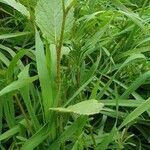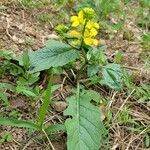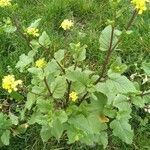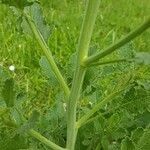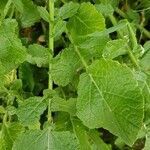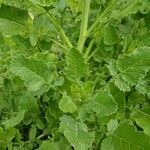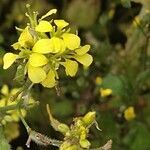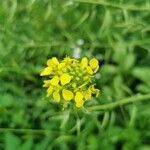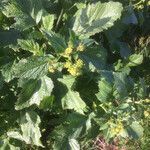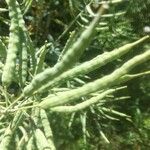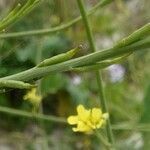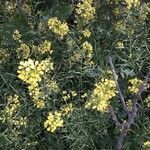Plants hirsute, hispid, or glabrous. Stems unbranched or branched, (0.5-)2-10(-21) dm, (often hirsute or hispid, sometimes glabrous, trichomes retrorse or spreading). Basal leaves: (proximal) petiole 1-4(-7) cm; blade obovate, oblong, or lanceolate, (3-)4-18(-25) cm × 15-50(-70) mm, margins lyrate, pinnatifid, or, sometimes, undivided; lobes 1-4 each side, margins of terminal and smaller lateral lobes coarsely toothed, (surfaces sparsely pubescent). Cauline leaves usually shortly petiolate, rarely subsessile; blade margins often not divided, coarsely toothed. Fruiting pedicels ascending or suberect, (2-)3-7 mm. Flowers: sepals (yellow or green), (4.5-)5-6(-7) × 1-1.8 mm; petals bright yellow, (8-)9-12(-17) × (3-)4-6(-7.5) mm; filaments (3-)4-6 mm; anthers 1.2-1.5 mm. Fruits linear, (1.5-)2-4.5(-5.7) cm × (1.5-)2.5-3.5 (-4) mm; valvular segment terete, (0.6-)1.2-3.5(-4.3) cm, (2-)4-8(-12)-seeded per locule; terminal segment (straight or upcurved), conical or subulate, terete, (0.7-) 1-1.6 cm, shorter than valves, seedless or 1-seeded; valves glabrous or pubescent, trichomes of 1 type. Seeds reddish brown to black, (1-)1.5-2 mm diam. 2n = 18.
Erect, branched, annual herbs up to 1 m high; lower part of stem densely hispid with coarse, spreading or retrorse hairs, sparsely hispid to subglabrous in the upper part. Leaves up to 20 cm long, usually hispid at least on the lower surface of the nerves. Lower leaves petiolate, lyrate-pinnatifid, 4-6-jugate; terminal lobe obovate, obtuse, ± confluent with the upper lateral lobes, coarsely dentate; lateral lobes ± oblong, dentate. Upper leaves sessile or shortly petiolate, ovate-oblong to lanceolate, acute, serrate-dentate. Flowers yellow, the petals c. 1 cm long. Fruiting pedicels short, stout, erect-spreading. Siliquae 2.5-4 cm long (including the beak), 2.5-4 mm in diameter, ± terete; valves 3-5 nerved, glabrous or hispid; beak 1-1.5 cm long, conical-subulate, frequently 1-seeded. Seeds mostly 8-12, globose, 1-1.4 mm in diameter, reddish-brown or brown-black.
Annual taprooted herb. Stems erect, branching, bearing stiff reflexed hairs especially near base or sometimes glabrous, 50-70 cm tall. Lvs glabrous or with sparse coarse hairs, toothed. Lower lvs lyrate-pinnatifid to lyrate-pinnate, 8-20 × 3-10 cm; terminal leaflet ovate, elliptic or oblong, not lobed, wider than rest of lf; lateral leaflets alternate, ovate to triangular, in (0)-1-3 pairs, the proximal ones sometimes entire. Upper lvs smaller, sessile, not lobed, ovate to oblong to linear. Racemes erect, to 40 cm long, glabrous or with sparse reflexed hairs. Pedicels erect or erecto-patent at fruiting, 3-6-(25) mm long. Sepals ovate to obovate, glabrous, 4-7 × 1.5-3 mm. Petals 4-9 × 1.5-4 mm. Silique 8-20-seeded, constricted or not between the seeds, glabrous or hairy, 25-40 × 1.5-3 mm; beak conic or somewhat flattened, 0-1-seeded, < or = valves.
Annual herb, erect, 30–80 cm tall, simple or branched, usually hispid, sometimes glabrous. Leaves to 20 cm long; basal leaves petiolate, lyrate, the terminal lobe large, dentate; cauline leaves simple, lanceolate, dentate, the upper ones sessile. Sepals 4–7 mm long, spreading. Petals 9–12 mm long. Siliqua 2.5–5.5 cm long, 2–4 mm wide, terete, spreading on thick pedicels 3–7 mm long; beak to 15 mm long, straight, conical, often 1-seeded; valves glabrous or hispid, 3-or 5-veined, contracted between seeds. Seeds 1–2 mm wide, red-brown or blackish, 6–12 per locule.
Annual herb, 0.5-1.0 m high, erect, branched. Stems hispid in lower part, sparsely hispid to subglabrous in upper part. Leaves hispid on lower surface of nerves; lower leaves petiolate, lyrate-pinnatifid, 4-6-jugate, lateral lobes oblong, dentate, terminal lobes obovate, obtuse, coarsely dentate; upper leaves sessile or shortly petiolate, ovate-oblong to lanceolate, serrate-dentate. Inflorescence a raceme. Flowers yellow. Fruit a siliqua, terete, valves 3-5-nerved, glabrous or hispid, beak conical-subulate. Seeds globose, reddish brown to brown-black.
Rough-hairy to subglabrous annual 2–8 dm; lvs obovate, the lower coarsely toothed or sometimes lobed, the upper progressively reduced, merely toothed; fls 1.5 cm wide; mature pedicels ascending, 5 mm; frs ascending, linear, subterete, the body 1–2 cm × 1.5–2.5 mm, smooth or rarely bristly; beak flattened-quadrangular, commonly half as long as the body; seeds 7–13, smooth, 1–1.5 mm; 2n=18. A European weed, now widespread in fields, gardens, and waste places in the U.S. May–July. (Brassica arvensis; B. kaber)
A cabbage family herb. It is an erect annual plant. The mature plant is 80 cm to 1.4 m high. The leaves are 5-15 cm long and 2-5 cm wide. They are hairy and there are teeth around the edge. There can be lobes near the base. The flowers are yellow and are clustered along the stem. The fruit is like a pod and is about 2 cm long. The valves on the fruit contain 3-5 distinct petals. The pods have more than 10 seeds.
Erect, branched, annual herb, up to 1 m high. Valves of fruits 3-or more-nerved. Fruits spreading, 20-40 mm long, 2.5-4.0 mm in diameter, beaked. Flowers yellow.
Lower leaves up to 20 cm. long, stalked, lyrate, roughly hairy, upper ones sessile, lanceolate, coarsely toothed.
Flowers bright yellow, pedicellate, pedicels 2–4 mm. long, in terminal racemes or panicles.
Annual herb up to about 80 cm. tall, with sparsely strigose stems.
Silique 20–40 x 1––3 mm. with conical beak 10–20 mm. long.
Seeds dark reddish-brown.
Petals 5–12 mm. long.
